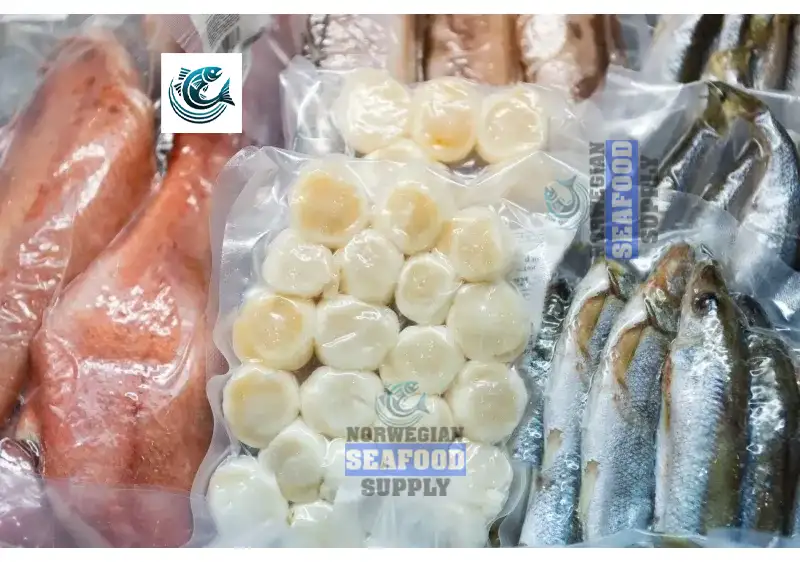- Building 6530 AVERØY, Norway
- info@norwegian-seafoodsupply.com
- +4793867180
Ultimate Guide to Storing and Preparing Frozen Seafood at Home
- Home
- Ultimate Guide to Storing and Preparing Frozen Seafood at Home

- by Admin,
- 13 May, 2025
Ultimate Guide to Storing and Preparing Frozen Seafood at Home
Introduction: Why Frozen Seafood Deserves a Spot in Your Kitchen
Frozen seafood often gets a bad rap—but unfairly so. With modern freezing technology, seafood can be preserved at peak freshness, offering a healthy, affordable, and convenient alternative to fresh fish that isn’t always available or practical.
At Norwegian Seafood Supply, we believe in bringing premium quality seafood from ocean to table. Whether you’re a seasoned cook or just starting out, understanding how to store, thaw, and prepare frozen seafood correctly can make all the difference in flavor, nutrition, and safety.
Section 1: The Science of Freezing - How Frozen Seafood Stays Fresh
Modern flash-freezing locks in nutrients and flavor, often within hours of catch. Unlike old freezing methods that caused texture damage, today's techniques preserve taste, color, and texture—making frozen seafood a healthy option that's almost indistinguishable from fresh when handled right.
Flash Frozen vs. Regular Frozen Seafood
Flash-frozen seafood is quickly brought to sub-zero temperatures (-21°C or colder), preventing large ice crystals from forming. This protects the seafood's cell structure, unlike traditional freezing, which can compromise quality.
Section 2: How to Store Frozen Seafood at Home
Best Practices for Storage
To maintain the quality and safety of your seafood, follow these storage tips:
-
Keep your freezer at -18°C (0°F) or colder
-
Use vacuum-sealed bags or airtight containers to prevent freezer burn
-
Label your seafood with the date of freezing
-
Avoid overloading the freezer to ensure air circulation
Related Keyword Usage: How to store frozen seafood, Seafood freezer guide, Storing seafood at home
Common Questions
What is the best way to prevent freezer burn on seafood?
Use vacuum sealing or tightly wrapped plastic with aluminum foil. Keep the temperature consistent and avoid opening the freezer too often.
Can you freeze seafood in its original packaging?
Only if it’s airtight. If not, rewrap it with moisture-resistant materials.
Section 3: Thawing Like a Pro - Safe and Effective Defrosting
Thawing incorrectly is one of the most common mistakes when preparing frozen seafood. Here's how to do it right.
Best Way to Thaw Frozen Seafood Safely
-
Refrigerator Method (Best): Place the seafood in the fridge overnight.
-
Cold Water Method (Faster): Seal it in a plastic bag and submerge it in cold water, changing water every 30 minutes.
-
Cook from Frozen: Certain items like shrimp and fish fillets can be cooked directly from frozen without thawing.
Related Keyword Usage: How to thaw frozen fish, Best way to defrost seafood, Safe seafood handling
Common Questions
Is it safe to refreeze seafood after it has thawed?
Only if thawed in the fridge and hasn’t been left at room temperature for more than two hours.
How long does thawed seafood last in the refrigerator?
1 to 2 days, depending on the type.
Section 4: Cooking Frozen Seafood - Tips for Flavor and Texture
Can You Cook Seafood Directly From Frozen?
Yes! Some types like frozen salmon and frozen shrimp cook beautifully without defrosting. Adjust cooking time and monitor doneness.
Popular Cooking Methods
-
Baking: Ideal for frozen fish fillets like tilapia or cod. Season, wrap in foil, and bake.
-
Sautéing: Perfect for shrimp. Cook in garlic butter or olive oil straight from frozen.
-
Grilling: Best for thawed steaks like tuna or swordfish.
Related Keyword Usage: Cooking frozen seafood, Frozen salmon preparation, Frozen shrimp cooking methods
Common Questions
Do you need to rinse frozen seafood before cooking?
Yes, give it a quick rinse under cold water to remove any ice crystals.
How do you add flavor to frozen seafood while cooking?
Use citrus, herbs, marinades, or compound butters. Steaming seafood with aromatic vegetables adds layers of flavor.
Section 5: Safety First - Handling Seafood at Home
Safety is crucial when handling frozen seafood. Keep these tips in mind:
-
Wash hands, surfaces, and utensils before and after handling
-
Never thaw at room temperature
-
Cook to a safe internal temperature (63°C/145°F for most fish)
-
Discard seafood that smells overly fishy or ammonia-like
Related Keyword Usage: Safe seafood handling, Seafood storage tips
Common Questions
How do you know if frozen seafood has gone bad?
Look for excessive frost, discoloration, off smells, or a spongy texture.
What types of seafood freeze the best?
Fatty fish like salmon, whitefish, shrimp, and crab all freeze exceptionally well.
Section 6: Beyond the Basics - Expert Insights & Common Pitfalls
Expert Insight
Chef Marie Watson, seafood expert and culinary instructor:
“Properly cooked frozen seafood can be as delicious and nutritious as fresh. It's all about technique and quality sourcing.”
Mistakes to Avoid
-
Thawing seafood on the counter
-
Overcooking (especially shellfish)
-
Not patting seafood dry before cooking
-
Storing seafood near strong-smelling items in the freezer
Real-Life Example
After a long day, busy professional James Nguyen relies on frozen salmon from Norwegian Seafood Supply. "I pan-sear it straight from frozen with a dash of soy sauce and lemon. Dinner in 15 minutes, and it tastes amazing."
Conclusion: Make the Most of Frozen Seafood at Home
Whether you're meal prepping for the week, cooking a romantic dinner, or feeding a hungry family, frozen seafood is a reliable, nutritious, and delicious choice. With the right storage, thawing, and cooking techniques, you'll get the most out of every fillet, shrimp, or crab leg.
Explore our premium selection at Norwegian Seafood Supply and bring restaurant-quality seafood to your home kitchen.

3 Comments
Be the first to comment